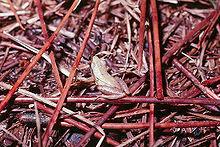Little grass frog
Appearance
| Little grass frog | |
|---|---|

| |
| Scientific classification | |
| Kingdom: | |
| Phylum: | |
| Subphylum: | |
| Class: | |
| Order: | |
| Family: | |
| Subfamily: | |
| Genus: | |
| Species: | P. ocularis
|
| Binomial name | |
| Pseudacris ocularis | |
| Synonyms | |
| |
The little grass frog (Pseudacris ocularis) is a species of chorus frog endemic to the Southeastern United States.
Geographic range
The little grass frog is found in the coastal plain of southeastern Virginia, eastern North Carolina, eastern South Carolina, and southern Georgia, as well as in western and peninsular Florida.
Description
P. ocularis is the smallest frog in North America, only reaching a maximum head-body length of 19 mm (0.75 in). It is normally pale brown, but can have a green or pink tinge.
Habitat
This species is mostly found around marshy swamps.
References
- Template:IUCN2006 Database entry includes a range map and justification for why this species is of least concern
- "Species Profile: Little Grass Frog". Savannah River Ecology Laboratory. Retrieved 2011-08-08.
Further reading
- Behler JL, King FW. 1979. The Audubon Society Field Guide to North American Reptiles and Amphibians. New York: Knopf. 743 pp. ISBN 0-394-50824-6. (Limnaoedus ocularis, p. 410 + Plate 172).
- Boulenger GA. 1882. Catalogue of the Batrachia Salientia s. Ecaudata in the Collection of the British Museum. Second Edition. London: Trustees of the British Museum. (Taylor and Francis, printers). xvi + 503 pp. + Plates I-XXX. (Chorophilus ocularis, pp. 333–334).
- Collins, Henry Hill Jr. 1959. Complete Field Guide to American Wildlife: East, Central and North. New York, Evanston, and London: Harper & Row. xix + 683 pp. + Plates 1-48. (Hyla ocularis, p. 443 + Figure 114 and map on p. 444).
- Conant R. 1975. A Field Guide to Reptiles and Amphibians of Eastern and Central North America, Second Edition. Boston: Houghton Mifflin. xviii + 429 pp. + Plates 1-48. ISBN 0-395-19979-4 (hardcover), ISBN 0-395-19977-8 (paperback). (Limnaoedus ocularis, pp. 326–327 + Plate 47 + Map 283).
- Holbrook JE. 1842. North American Herpetology; or, A Description of the Reptiles Inhabiting The United States. Vol. IV. Philadelphia: J. Dobson. 138 pp. + Plates I-XXXV. (Hylodes ocularis, pp. 137–138 + Plate XXXV).
- Wright AH, Wright AA. 1949. Handbook of Frogs and Toads of the United States and Canada. Third Edition. Ithaca, New York: Comstock. xxii + 640 pp. (Pseudacris ocularis, pp. 264–267, Plate LVI, map 18).

